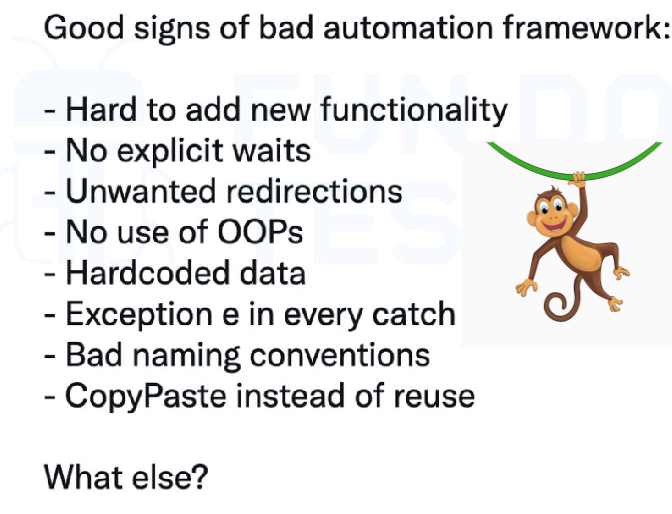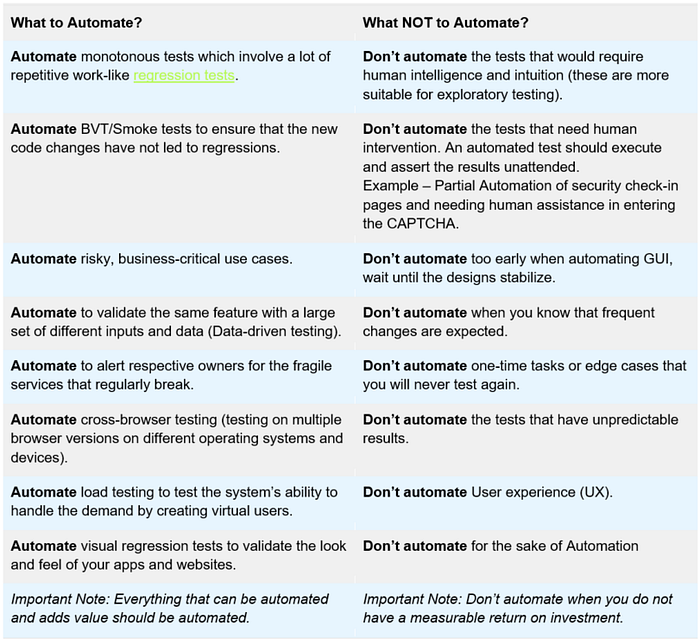Is your test automation on track? Maintenance is the key factor
 NonStop io Technologies
NonStop io Technologies
Hello Readers,
We are going to discuss the Automation framework and will discuss framework maintenance too. In today’s time, every company wants to focus on automation because somewhere automation helps in project management and adjusts cost project costs.
Test creation in Framework
Test creation is one of the skills of the best QA. We must focus on choosing correct, important scenarios or use cases to automate. The addition of correct tests into the automation framework is the first positive step towards good automation.
A Test Case is a set of inputs, execution preconditions, and expected outcomes developed for a particular objective, such as to exercise a particular program path or to verify compliance with a specific requirement.”
Tips for writing good tests
Tests only one thing — Always make sure that your test case tests only one thing, if you try to test multiple conditions in one test case it becomes very difficult to track results and errors.
Organize your test cases consistently — You can organize your test cases in many ways however you should always follow the same pattern to organize your test cases.
Use the correct template for writing the test cases
Framework Creation
Test automation is the process of automating repetitive and predictable testing scenarios.
A test automation framework is a set of guidelines or rules that can be used to define test cases. These test cases can then be configured and implemented using test automation tools such as Selenium, Puppeteer, etc., to the delivery process via a CI/CD pipeline.
Increased speed and efficiency of the overall testing process
Improved accuracy and repeatability of the test cases
Lower maintenance requirements with standardized practices and processes
Reduced manual intervention and human error
Maintenance of automation framework
Maintenance of framework is a critical, most important task in framework design. Most people and does not focus on this part while designing the framework for their tests. Maintenance is an important factor, not focusing on this can lead to failure of the created framework.
Without a doubt, automated testing has transformed the way software development works. If it wasn’t for Selenium, we wouldn’t be able to use such a wide array of bug-free web apps as we do. But sometimes, even the IT sector misunderstands the term automation.
Most people assume that the computer is going to accomplish all the testing for them! They also end up thinking that they can automate the entire product. Well, I’m not saying they can’t, but with complete automation comes the responsibility of its maintenance. After all, it’s not always a forget-it-after-setting-it approach! Automation generates maintenance costs that you can’t easily overlook.
So, what’s the biggest nightmare of any test automation engineer? Now we know that it’s automation test maintenance. Even a minor change in the UI has the potential to break tests. This calls for an ideal maintenance process for Selenium or Cypress.
When the tests that are already working might begin to fail. What should be the first reaction to a failed test? Of course, determine the reason behind the failure. Sometimes there can be defects in the software. Other reasons can be unforeseen side effects and changes in behavior. In this case, fixing the code or updating the tests can help. Sometimes, the team might have to do both.
If your test framework can’t update tests after changing behavior, you need to rethink your framework.
Creating an automated UI test framework can be a bit of a painful process but maintenance of the framework should definitely not be painful. Start by setting up and organizing a folder structure for your test assets. You’ll want to keep different assets separate from each other, such as tests, name mapping criteria, and scripts, and create the files you know you’ll need within each one. For example, within your ‘Scripts’ folder, you’ll want to create files for each type of script –event scripts, actions, utilities, and verification. Also make sure to create a file for your data.
Structuring your assets in this manner will allow for them to be quickly referenced by members of your team and will ensure your tests are stable when updates are made. When structuring your assets in this fashion, you can revisit the project at any time without the pain of needing to sort through a lot of information. This will also templatize your test folders, enabling you to clone them across a project.
Step two is to start familiarizing yourself with the application — beyond what the requirements can tell you. Reading documents that outline what the app should and shouldn’t do will only get you so far. In this step, you want to get your hands dirty. Conduct exploratory testing to give yourself an idea of how the internal workflows of the system are set up.
Harnessing data and extracting useful information is the biggest hassle during software testing automation. The availability of data to carry out tests is usually a major problem. To ensure the success of automation efforts, it’s necessary to have a strategic test data management approach.

Points to be noted……
Various test automation frameworks exist, each with a different logic:
Keyword-driven framework. This is a popular approach to automated functional testing. You break down the test logic into keywords and functions and store them in a separate Object Repository. Then call it in when you need to run a test.
Modular-driven framework. In this case, you analyze all available test cases to identify repeatable flows. Then turn these reusable flows into functions and score them as test scripts. To perform different testing scenarios, you then re-use or combine these modular scripts.
Behavior-driven framework. All application behaviors are defined through human-readable test commands (e.g. register an account). Then these are codified into test cases using BDD tools.
Data-driven framework. You build your test cases around available test data, stored in a table or spreadsheet format. Then run a single test script to validate all the data and generate outputs in the same table.
Hybrid framework — any combination of the above AQA frameworks.
With the help of the above framework design, you can create any framework. First, verify the requirements of the project and then decide on the framework design. Each time we should need to ask ourselves some questions about ourselves and the team responsible for the framework and automation test.
Are we on the right track to framework design?
Our framework will help to minimize our efforts in testing?
Is the framework structure quite lengthy and disturbed?
If you are getting positive answers then you are in good shoes to proceed. Enjoy the creation of new things. It brings a beautiful experience.

Subscribe to my newsletter
Read articles from NonStop io Technologies directly inside your inbox. Subscribe to the newsletter, and don't miss out.
Written by

NonStop io Technologies
NonStop io Technologies
Product Development as an Expertise Since 2015 Founded in August 2015, we are a USA-based Bespoke Engineering Studio providing Product Development as an Expertise. With 80+ satisfied clients worldwide, we serve startups and enterprises across San Francisco, Seattle, New York, London, Pune, Bangalore, Tokyo and other prominent technology hubs.